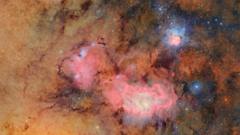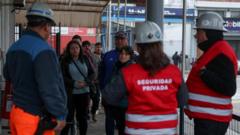**The debut images from the Vera Rubin Observatory herald a new era in astronomy, potentially revolutionizing our understanding of celestial phenomena and the cosmos.**
**Historic Unveiling of First Images from Breakthrough Telescope**

**Historic Unveiling of First Images from Breakthrough Telescope**
**The Vera Rubin Observatory's Initial Photos Offer an Unprecedented Glimpse into the Universe**
A new era in astronomy has been inaugurated with the unveiling of the first images from the Vera C. Rubin Observatory in Chile, showcasing the Trifid and Lagoon nebulae in remarkable clarity. The observatory, which houses the world's most advanced digital camera, is set to redefine our grasp of the universe through its deep-space imaging capabilities.
Situated in the optimal environment of the Chilean Andes, the observatory will embark on a transformative ten-year survey of the southern night sky. The telescope's advanced design allows it to scan for elusive celestial objects, including potential ninth planets and hazardous asteroids, while also probing the enigmatic realm of dark matter, which comprises a significant portion of our universe.
Professor Catherine Heymans, the Astronomer Royal for Scotland, expressed her excitement about the project, highlighting a commitment that spans decades to create a facility of such exceptional caliber. The UK is contributing to this groundbreaking research by hosting data centers for processing the detailed images captured by the telescope.
The telescope's impressive 3,200-megapixel camera, constructed by the Department of Energy’s SLAC National Accelerator Laboratory, is capable of capturing every minute detail of the cosmos. Its three-mirror system maximizes light collection efficiency, enabling astronomers to observe events from billions of years ago with pinpoint precision.
The observatory is designed to maintain a dark environment essential for accurate visualization, with strict controls over stray light sources. Each night, the telescope will capture images every 40 seconds for around 8-12 hours, generating a staggering amount of data—potentially reaching 10 million alerts nightly.
This innovative survey, focusing on areas such as transient celestial bodies, the structure of the Milky Way, and the exploration of dark matter, will continuously monitor and refine our understanding of cosmic phenomena. Its persistent observations will lead to novel discoveries, possibly including insights into the long-speculated Planet Nine.
As scientists prepare to delve into the vast data sets, expectations soar regarding breakthroughs in our understanding of the universe, potentially illuminating the celestial abyss that has intrigued humanity for centuries. The Vera Rubin Observatory stands on the precipice of a transformative journey, ready to unveil the cosmos’ hidden secrets.
















